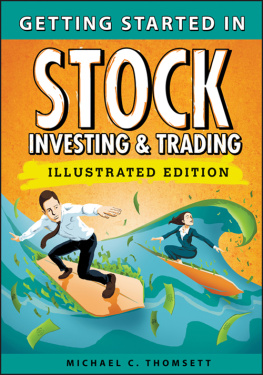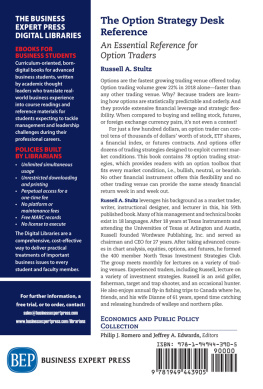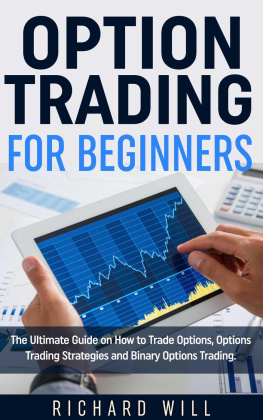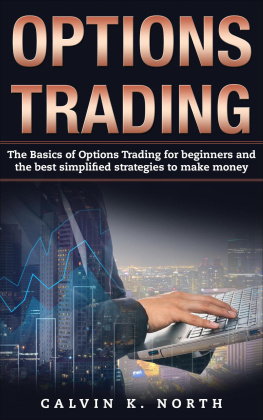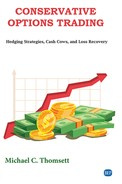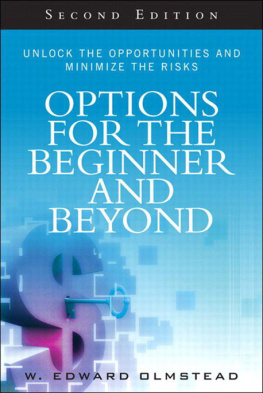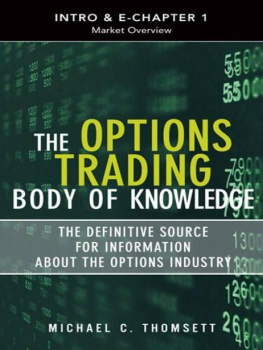
The Options Trading Body of Knowledge
(Introduction & Chapter 1)
Market Overview
Michael C. Thomsett
2010 by Pearson Education, Inc.
Publishing as FT Press
Upper Saddle River, New Jersey 07458
Company and product names mentioned herein are the trademarks or registered trademarks of their respective owners.
All rights reserved. No part of this book may be reproduced, in any form or by any means, without permission in writing from the publisher.
Introduction
Enhancing profits is a goal for every stock investor. The options market is one avenue to achieving this goal, but it is complex; within the market itself, there are many ways to trade. This makes the options market both exciting and potentially risky.
The scope of possible strategies can be overwhelming for an options trader. The basic tradesbuying calls or puts for speculationare only the most obvious uses of options. They can be used in a broad range of expanded strategic applications. Some are very high-risk, and others are very conservative.
One of the most popular strategies is the covered call , which involves selling one call against 100 shares of stock owned. A covered call seller (also called a writer) receives a premium when the option is sold, and that premium is profit if the call ends up expiring worthless. The short position can also be closed at any time or held until exercise. In any of these outcomes, the trader continues to earn dividends on the stock and has a lot of control over the outcome. A properly selected covered call can easily create double-digit profits in any of the possible outcomes. This makes the strategy practical for most people.
On the far side of the spectrum is the practice of selling naked options. When traders do this, they receive premium income, but they also risk exercise and potentially large losses. Many variations of naked writes might be used to mitigate the market risk. In between the very conservative and the very high risk are numerous other strategies. Options can also be used to hedge stock positions, reduce risk, and enhance profits in many ways.
This book is designed to provide readers with a comprehensive reference for the entire options market. Most people prefer to focus on the listed options available on individual stocks, and this is the focus of the examples provided in the Option Strategies chapters. However, options are also available on futures, indices, and mutual funds, and the options market has expanded beyond its original limited scope and size. In the 1970s, when publicly traded options first became available, only a few traders even knew about options. Today, the entire options market has become mainstream, and a growing number of people are recognizing that options can provide many roles within a market portfolio and can serve a broad range of risks.
The one change in technology that has made the options market so widely accessible has been the Internet. Two developments have significantly affected the way that traders are able to trade and can afford to be in the market at all. First is access itself. With the Internet, anyone can go directly to current option listings and track their holdings or identify opportunities. Only a few short decades ago, before the Internet existed, options traders had to rely on stockbrokers, which meant having to visit or telephone an office, wait for the stockbroker to look up listings, and then decide on whether to make a trade. Any stockbroker who was not physically on the floor of an exchange had a considerable time lag as part of this process, making active trading impossible.
The second major change is cost. In the old days when you could only trade through a broker, commission costs were quite high compared to todays cost. With widespread use of online discount brokerage services, options trades cost as little as a few dollars, with the average ranging between seven and ten dollars each way. So a round trip (buy and sell) can be accomplished for less than quarter of one point, which is a huge discount over commission costs of the past.
Do you need a broker? This is the question that every trader has to deal with when thinking about moving to a discount service, where trade execution is offered without advice. Ironically, the answer for options trading is that you not only do not need a broker, but using one means you probably should not be trading options. By definition, any trader who has enough experience or knowledge to actively trade options should be using a discount broker. The concept of asking a brokers advice for an options trade is nonsensical for three reasons. First, stockbrokers are not necessarily skilled within the options market, even if they are licensed to execute options trades. Second, options trading demands on-going tracking of both options and the stocks they refer to. Third, paying a high commission to a full-service brokerage firm erodes profits from options trades, making many strategies marginal or impractical.
This book is designed for the options trader, whether a novice or skilled pro, who understands and appreciates the market issues. They are going to be more likely than average to employ a discount brokerage service, to make their own decisions, and to monitor their investments. Full-commission brokerage is appropriate only for clients who are worried about risk, who are less knowledgeable about markets, and who trust their broker to give them sound advice. This is a large market, although it is not growing. In comparison, the options market is growing and expanding. Not only are options available today on more products than ever before, but the volume of trading has also grown at incredible speed. In 1973, slightly more than one million contracts were traded. In 2007, more than 944 million traded. In the 34 years between 1973 and 2007, the annual volume declined only seven times. But the recent explosion of the options market has been impressive. For example, between 2006 and 2007, total volume grew by 40 percent; the previous year, growth was 44 percent. The future of this market is going to be even bigger, and a growing number of investors will use options in some form as an integral feature of their portfolio. This alone is a substantial change in the options market.
In the past, options have been viewed by the crowd of Wall Street as an oddity, a side-bet, or an entirely separate market, appropriate only for speculators. But as new products and new strategies have been developed, this outlook has evolved. Today, retail and institutional investors use options to (a) insure long portfolio positions, (b) hedge short risks, (c) play short-term market price swings, and (d) enhance profits. Even in the most basic of portfolios, all these applications of options make them valuable management and riskreduction tools. The most basic speculation in options is an entry strategy for many options traders, but it is becoming less important over time. Today, the options market has grown into a means for taking a lot of risk out of the investment equation.
This book provides a market overview and discussion of risks, in addition to a comprehensive listing of strategies. Most of these strategies are accompanied by tables and illustrations identifying profit and loss zones, as well as breakeven points. The strategy section uses companies for examples. These are based on actual option values for three publicly listed companies; however, their names have been changed due to the ever-evolving share prices of each. All the stock prices and option premium values are based on the closing values of those stocks and options as of December 31, 2007. By using this fixed moment in time, all examples are based on the same data. However, even though stock and option valuation changes constantly no matter when you analyze relative values, the approximate option risks and opportunities remain identical. As long as time to expiration is the same as that in the examples, and proximity between strike price and current market value remains within the same range, the values of options and the likely outcome of strategies will work in the same manner.
Next page


